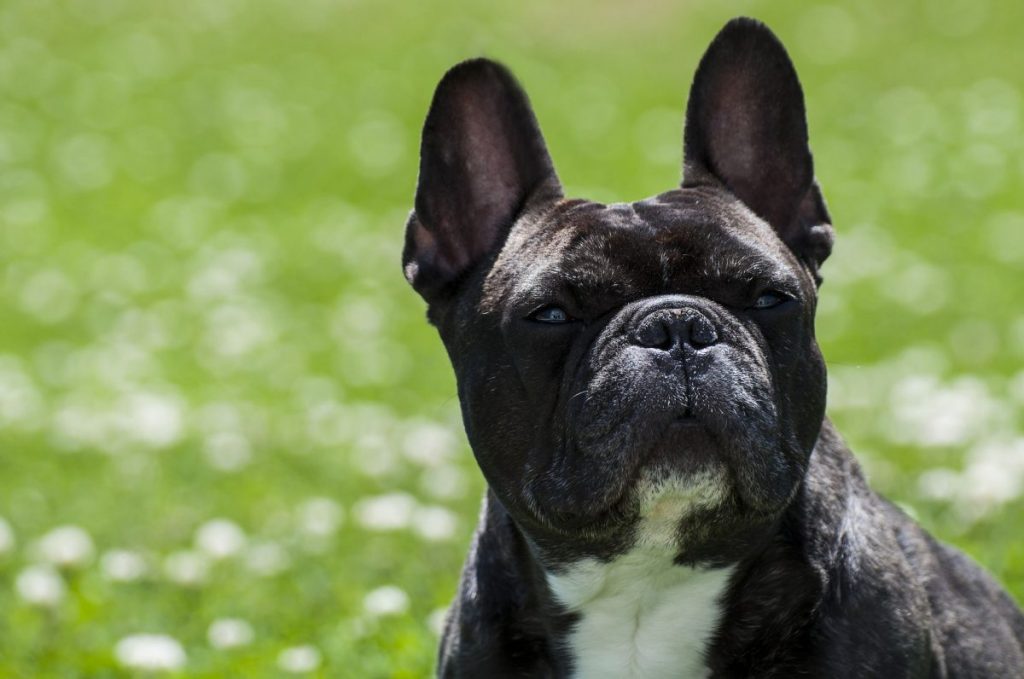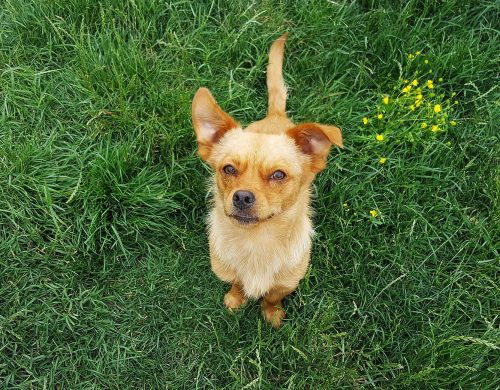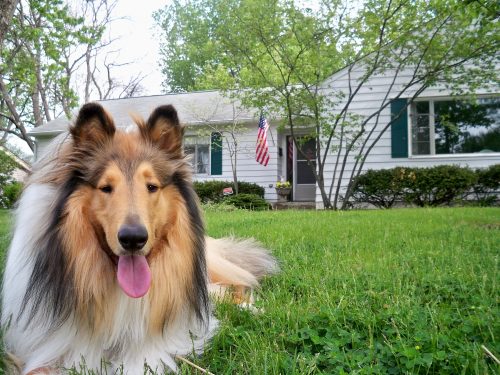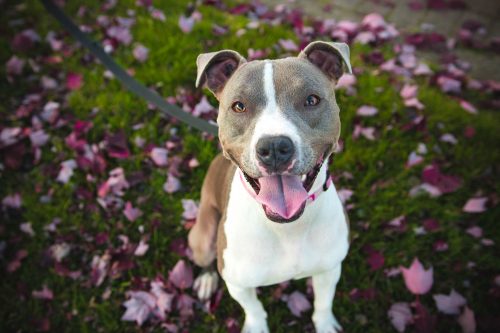Bringing home a new puppy or adult dog is an exciting adventure, but cozy cuddles and energetic playtime also come with a number of training responsibilities. To help avoid accidents at home, take the time to potty train your dog in order to avoid future mishaps. Although accidents may happen, training your dog to use the bathroom outside is a lifelong behavior that will make both of your lives easier.
Potty Training a Puppy vs. Potty Training an Adult Dog
Whether you are training a puppy or an adult dog to use the bathroom outside, there are a few critical steps to take including establishing a routine, rewards for good behavior, supervision when you are home, and confinement when you are away.
The primary difference between potty training a mature dog versus a young dog is that an adult dog can hold his bladder and bowel for a longer period of time. This does not mean that it is okay to force your dog to “hold-it” for hours on end, but it does mean that you have more flexibility with your training schedule.
While puppies can typically only wait two hours between trips outside to use the bathroom, adult dogs can wait several hours. This is helpful if you are not available every two hours during the training period. Take this into consideration when deciding if you should add a puppy or adult dog into your fur family.
Set a Schedule
The most critical part of training your dog to use the bathroom outside is to set a schedule. Dogs are creatures of habit, and creating a routine is the most effective way of teaching a dog when and where to do his business. This means not only setting a schedule for bathroom time, but it also means establishing an eating schedule to help regulate your dog’s digestive system.
Start setting your dog’s routine by deciding what times throughout the day you can take him outside to use the bathroom. Times that typically work well are first thing in the morning when you wake up, every two hours thereafter (if you are training a puppy), after playtime, and after mealtime. Once your dog becomes accustomed to the routine, he will know when the appropriate times are to use the bathroom.
In addition to creating a regular schedule, you should also teach your dog where to go to the bathroom. Take your dog to the same spot each time so that he knows that this is the designated bathroom area. You can either take your dog on a leash or set up a confined area. The more consistent you can make your routine, the easier it will be for your four-legged friend to understand when and where to use the bathroom.
Similar to commands such as “sit” or “stay,” key words and phrases are also helpful in establishing a restroom routine. If you select a command such as “outside” or “go potty” every time you want your dog to use the bathroom outside, it will help reinforce the concept. The more consistency you can integrate into your dog’s routine, the more effective the process.
Another way to set your dog’s bathroom routine is by feeding him at the same time each day. Leaving the food bowl down throughout the day will lead to your dog needing to use the bathroom at various times. This sets your dog up for an accident, so you should create a schedule to help regulate your dog’s digestion.
Do this by putting the bowl down for only fifteen minutes and then taking it away. By putting down the bowl at the same time each day and then taking it away, your dog will learn that this is when he needs to eat. Although this training may take a few days, when your dog is hungry and the food is down, he will take the time to eat. Regulating your pup’s diet will help you to predict when he needs a potty break, reducing the risk of the accidents.
In addition to removing the food bowl after fifteen minutes, you can also take the water bowl off of the ground two hours before bedtime. Removing the water bowl is not necessary for adult dogs, but for a puppy that cannot hold his bladder as long, you may want to try it.
However, remember to put the bowl back first thing in the morning and ensure your dog has adequate access to water throughout the day. Even after removing the water bowl before bedtime, your puppy may still need to go outside during the night. If this is the case, try to stay quiet, calm, and keep the lights low. This will help your puppy understand that it is still nighttime and not playtime.
Praise and Punishment
Whenever your dog goes to the bathroom outside, it is important to reward him immediately. Carry a few pieces of kibble or healthy treats in your pocket so that if your dog goes to the bathroom outside, you are prepared to let him know what a good boy he is. Tasty treats are typically most effective, but verbal praise is a positive reinforcement as well.
A common mistake is praising and rewarding your pup after he is back indoors. This is a mistake because it trains your dog to think the reward is being given for going back in the house. This can be counterproductive because your dog may become distracted by the thought of going back in the house to get a treat as opposed to doing his business. Always praise your pooch immediately and administer praise outside in the bathroom area.
In terms of punishment, you should never scold or reprimand your dog for having an accident. Unless you catch your dog in the act of relieving himself in the house, you are already too late for any training. If you do catch your dog mid-bathroom break, immediately interrupt him. If possible, pick up your dog and take him to the designated outdoor bathroom space. If your dog finishes using the restroom outside, remember to give him praise and a treat.
It is a myth that rubbing your dog’s nose in the accident or scolding him in front of it will teach him not to use the bathroom in the house. Once a dog is done eliminating, it is out of his mind. Administering any type of punishment is ineffective and therefore cruel. You may do more harm than good by making your dog fearful of you and of going to the bathroom. Although it may be frustrating, focus on working on your routine and giving praise as opposed to punishment.
When your dog does have an accident in the house, it is important to thoroughly clean the area. If a scent is left behind, your furry friend will repeatedly return to this space as an indoor bathroom. This behavior should be avoided at all costs, so make sure you have the proper cleaning materials to rid the space of any remnants. If this becomes a reoccurring issue for you, try blocking off the area while you are still training your dog to use the bathroom outside.
Constant Supervision
Although this step in potty training is a lot of work, a dog that is learning when and where to use the bathroom needs to be supervised at all times. This is especially true with puppies that are more prone to accidents. Supervise your dog by keeping him in the same room as you.
If you have a large house and cannot block off the space, keep your dog on a generously long leash so that he can still explore while you go about your day. This may seem excessive, but while your dog is in training, it is critical that you catch accidents before they happen.
It is crucial for your dog to learn that the house is off-limits in terms of going to the bathroom, and you want to stop bad habits before they form. Keep a watchful eye on your pup so that you can put him outside before the opportunity arises to go in the house.
When supervising your dog, you should be on the lookout for warning signs that he needs to take a trip outside. If your dog is trying to let you know he needs to use the bathroom, he may bark or whine at the door. Less obvious signs include sniffing around the room, squatting, circling, and restlessness. Keep an eye out for these warning signs so that you can take your dog out and avoid an accident.
While potty training your dog, you should keep him on a leash and under supervision when he is outside and in the yard as well. Although this may seem extreme since the outdoors is where you want him to go to the bathroom, it is important when initially establishing the routine. Your dog needs to learn the appropriate time and place to go to the bathroom, so until your training is complete, keep him supervised both indoors and outdoors.
Crates and Confinement
The idea of confining your canine companion to a small space is often upsetting, but dogs are naturally den-dwelling animals and feel comfortable in cozy spaces. When crate training is done correctly, the crate can become a safe space that your dog will love.
This type of training has an added benefit because if your dog is comfortable in a crate, it will be easier to transport him when necessary. However, crate training can also be tricky. If done correctly it can be very beneficial, but if done incorrectly it can be scary and uncomfortable for your pup.
Crate training or putting your dog in a small, confined space such as a corner of the laundry room or bathroom can be very effective when you are unable to supervise your dog. In-person supervision is the preferred method, but when you need to leave the house, confinement is a good alternative.
Your crate or small space should be big enough for your dog to stand up and turn around, but not big enough that he can use the bathroom in one corner and then sleep in the other. The goal is to make your dog feel like this is his den, not a bathroom area. This method works with dogs because they are clean animals. A dog will not typically use the bathroom where he is sleeping, leading him to wait until you come home and let him outside.
It is important to note that puppies still cannot hold their bladders for more than two hours, and a crate is not a magic solution to being gone all day. Even older dogs who can go for longer periods of time without going to the restroom should not be left in the crate all day.
When left for hours on hours, your dog will be come anxious and depressed. This teaches your dog that the crate is a bad place, and he will feel like he is being punished. Similarly, the crate should never be used as a form of punishment. You want the crate to feel like a safe place where your dog can relax in solitude.
Another key part of crate training is to stop using the crate once your dog is 100% potty trained. Let your dog roam free and go into the crate voluntarily once you trust him not to use the bathroom in the house.
Patience and Practice
Depending on your dog’s history and personality, training him to use the bathroom outside may take months or a year. Dogs from pet shops are often difficult to train because they are used to being confined in small spaces, and in some cases, have been forced to use the bathroom in crate scenarios. Breeders can sometimes be responsible, as there is not always an established bathroom routine.
The same can be said for adopted dogs. The previous owner may not have bothered with training, or maybe the dog was always an outside dog previously. Regardless of your dog’s prior circumstances, all dogs are trainable regardless of breed, disposition, or age. Even though it may take some time, by sticking to your routine and practicing praise and patience, your dog will learn to use the bathroom outside.








